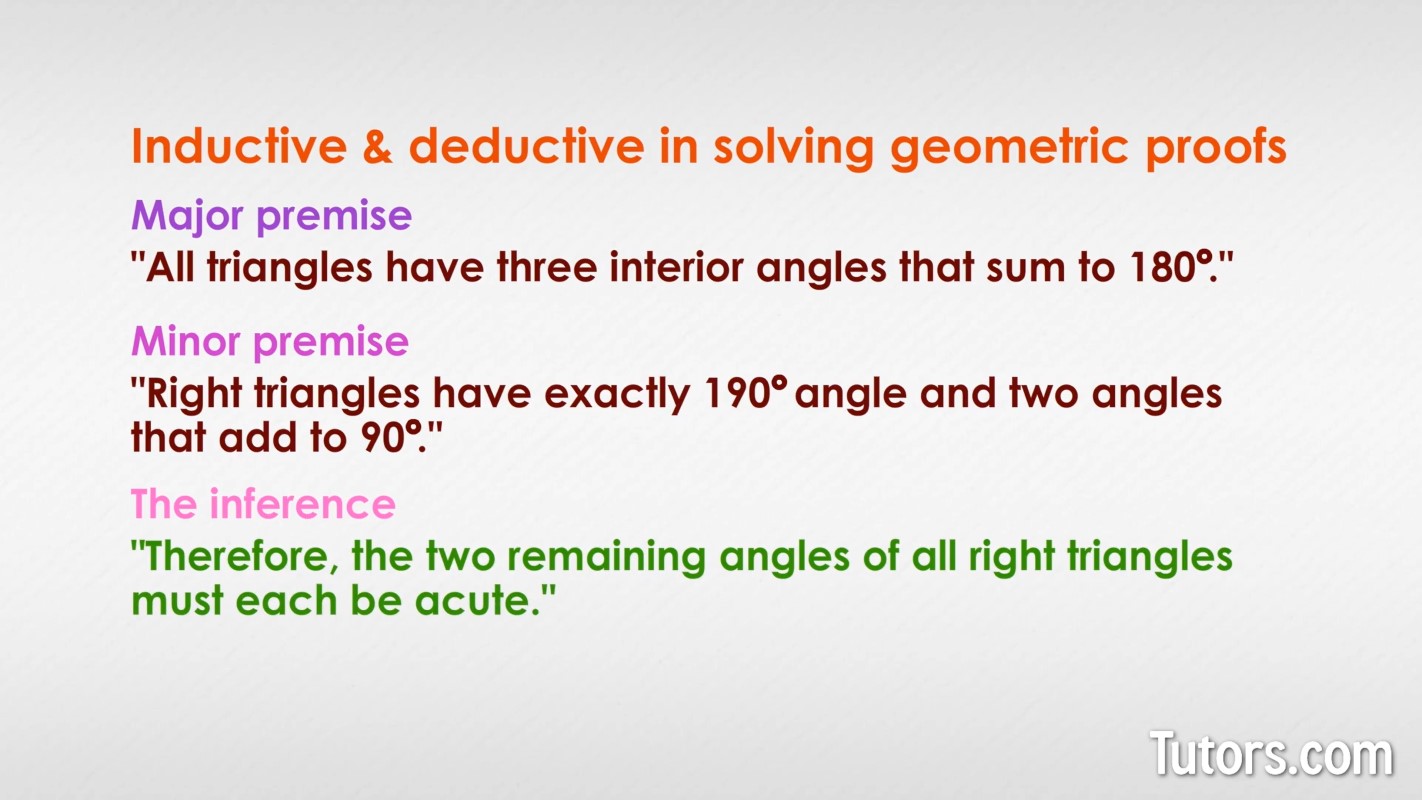Inductive & Deductive Reasoning in Geometry — Definition & Uses
Inductive and deductive reasoning
The words seem to be almost duplicates: inductive, deductive; aren't they nearly the same thing? Not at all! In this short piece we hope to show you why deductive reasoning is so helpful and inductive reasoning is so unreliable.
Mathematics and geometry in particular depend on clear thinking and logic. Deductive and inductive reasoning are tools we use to make the theorems, postulates, axioms and proofs do the heavy lifting for us.
To avoid confusing the two, remember that inductive reasoning starts with a few specifics and tries to create a general conclusion (which is not usually valid). Deductive reasoning starts with some general observations and deducts (wipes away) every unnecessary distraction to leave a specific, valid conclusion.
Famous detectives of popular literature depend almost entirely on deductive reasoning. From Sherlock Holmes to Nancy Drew to the Scooby Doo gang, anyone sleuthing for the truth uses deductive reasoning. Inductive reasoning, its opposite, does not yield reliable conclusions, but can get your logical mind rolling toward success.
Inductive reasoning
Inductive reasoning means coming to a very broad conclusion based on just a few observations. The flaw, of course, is that no one person can observe all cases of a particular issue, so inductive reasoning is, right out of the gate, flawed.
Answers arrived at from inductive reasoning can be valid, or they can just as likely be invalid. Human experience is limited by geography, years, language, and other barriers to complete understanding. Even the most Sherlockian of detectives can only observe a small portion of all examples of a situation. To base a conclusion on a limited series of observations is to invite trouble.
Why use inductive reasoning at all, then? We use inductive reasoning to "prime the pump" in mathematics; to give us a starting point, not a conclusion, for further questioning. Inductive reasoning allows you to create a hypothesis to then support or disprove.
Here is an example: You notice that all the butterflies in your backyard have brown and orange spots. From that single observation, can you draw a conclusion that all butterflies everywhere have brown and orange spots? No, but you can begin to research butterflies in your neighborhood, and make a hypothesis that some plant in the neighborhood attracts those particular butterflies.
Deductive reasoning
Good, clear inductive reasoning ("I wonder why I am seeing what I see? …") leads to deductive reasoning, a logical series of steps moving from a general premise to a specific and narrow conclusion.
With deductive reasoning, you start with a general statement and burrow down to a specific detail. Deductive reasoning done correctly always produces reliable, valid results.
Deductive reasoning has distinct steps:
A premise
A second premise
An inference linking the two premises
Here is an example:
All butterflies have long, club-shaped antennae ending in bulbs, while moths have feathery antennae
The insects in my backyard have long, club-shaped antennae ending in bulbs
Therefore, the insects in my backyard are butterflies, not moths
This solid piece of deductive reasoning started from a general premise (the major premise), went to a minor premise (something local and defined) and inferred the connection between them that gives a conclusion.
Applying reasoning to geometry
Inductive and deductive reasoning can be helpful in solving geometric proofs. Inductive reasoning is the start of any proof, since inductive reasoning develops a hypothesis to test.
You notice something specific about a localized case ("All these right triangles I see in my textbook also have two acute angles") and draw a universal conclusion that you will need to test ("All right triangles have two acute angles").
That conclusion, that all right triangles have two acute angles, is not reliable because you based it on the thin evidence of a few triangles from your textbook. You can test the conclusion using mathematical proof, relying on your storehouse of knowledge of axioms, postulates, and theorems proven by other mathematicians.
Switch to deductive reasoning and make a major and minor premise:

All triangles have three interior angles that sum to 180°
Right triangles have exactly one 90° angle and two angles that add to 90°
Therefore, the two remaining angles of all right triangles must each be acute
Notice that the first, major premise applied to all triangles. The second, minor premise zoomed in on only right triangles, our specific, localized case. The inference connected the two premises.
You can use many tools, such as the parallel postulate, triangle sum theorem, and alternate interior angles theorem, to conclusively prove that right triangles always have two acute angles. Having a familiarity and sharp memory of all the geometry tools will make logical reasoning quick and easy for you.
Your initial inductive reasoning led to a statement you tried to prove using deductive reasoning. You really were a bit of a detective, building a case from clues you uncovered.